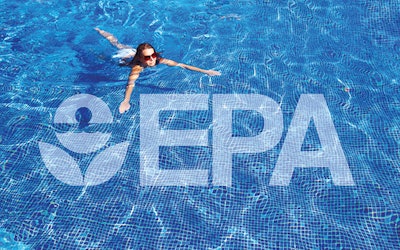
Although some members of the industry are unaware of the fact, the U.S. government regulates pool and spa chemicals and sanitizing equipment through an involved process designed to ensure these products’ safety and efficacy. It’s helpful to know something about the regulations and the process by which manufacturers achieve approval (registration) for their products.
The EPA is the branch of government that handles this function. The Agency refers to organisms like algae, bacteria and viruses that pool and spa owners are trying to keep out of their pools as “pests.” Therefore, in the EPA parlance, common sanitizers are called “pesticides,” and a unit of sanitizing equipment such as an ozone generator is called a “pest control device.”
Due to the legal and scientific scrutiny imposed during the registration process, use of EPA-registered pesticides and pest control devices from EPA-registered establishments provides a level of assurance not only about the legality of the pesticide or device, but also its efficacy and safety when used according to label directions. It is an important aspect of ensuring for our customers that the products are safe and effective.
PESTICIDES – THE PROCESS OF APPROVAL
The EPA defines a pesticide as a product that “incorporates a substance or mixture of substances designed to prevent, attract, repel, destroy or mitigate a pest.” This category includes sanitizers used in water treatment. In the field of recreational water, pesticides are generally directed at controlling algae and waterborne pathogens such as disease-causing bacteria, viruses and protozoan parasites.
Under the Federal Insecticide, Fungicide and Rodenticide Act, the EPA is charged with evaluating all pesticides to ensure that they comply with federal requirements regarding protection of human health and the environment. Before being sold or used in the United States, a pesticide must be granted a license or “registration” by the EPA.
RELATED: The Science of Starving Algae
Evaluation of the candidate pesticide includes consideration of the accuracy of label claims, efficacy as a pesticide, safety of workers or others who may directly or indirectly come in contact with the pesticide and the environmental impact of using the pesticide.
Establishments that produce pesticides (chemical manufacturers) must be registered with the EPA. A registered establishment is assigned an EPA establishment number that must appear on the labels of all EPA-registered pesticides produced by the establishment.
Registered products are required to meet rather exacting label requirements. Labels must include the following:
- A specific listing of all pesticidal active ingredients and their percentages in the product along with an indication of the total percentage of all inert ingredients
- The amount of product in the package
- Directions for use
- Precautionary statements regarding hazards to humans, domestic animals or the environment
- Physical and chemical hazards
- Directions for safe storage and disposal
- Warnings to keep the product out of reach of children
- First aid recommendations
- The name and address of the manufacturer
- The EPA establishment number(s) for the plant(s) in which the product is produced
- The EPA registration number assigned to the specific product from a specific company
Critical label wording is standardized to ensure clear communication and compliance with label requirements. Registered pesticides are also subject to periodic review and reevaluation by the EPA. In addition, the wording of any product performance claims that appear on the label must meet EPA requirements.
In addition to EPA registration, a pesticide must also be registered in the individual states in which it is to be sold. The state EPA or equivalent body will evaluate the pesticide using the same general criteria as the EPA uses, but may have additional requirements.
The clearest indication that a product has been granted registration is the presence of the EPA establishment number and EPA registration number on the package. Often these numbers will appear on the back or side label in fairly small print, but regardless of where they appear on the label, they must be present for the pesticide to be sold legally in the U.S.
To ensure that registered pesticides are used effectively, safely and in an environmentally sound fashion, federal law requires that the pesticide be used only as directed on the label. The label will state, “It is a violation of Federal law to use this product in a manner inconsistent with its labeling.”
RELATED: Alternative Sanitizers + Chlorine: The Quest for Synergy
PEST CONTROL DEVICES
Whereas a pesticide is a substance (chemical or formulation) designed to control pests, a device “uses only physical or mechanical means to trap, destroy, repel, or mitigate any pest and does not include any pesticidal substance or mixture of substances…”
Thus, devices like ozone generators (UV or corona discharge based), UV light systems and electrolytic halogen generators fall in the category of microbial pest control devices. Devices that simply dispense an EPA-registered pesticide, such as chlorine feeders, are not classified as pest control devices.
If the dispenser is not assembled and sold with the pesticide, the manufacturing location of the device does not need to be an EPA-registered establishment, and pest control device legal requirements do not apply. In such a case, the EPA regulates the pesticide, but the dispensing device is exempt. On the other hand, if a pesticide and device are packaged together, the combination is considered a pesticide and is subject to pesticide regulation.
Like pesticides, pest control devices made or used in the United States can only be manufactured in EPA-registered establishments. The manufacturer is required to obtain registration for the establishment before beginning production or distribution of the devices. This requirement even applies to foreign manufacturers selling products in the U.S.
Pest control devices are subject to the following label requirements:
- They cannot bear any statements that are false or misleading.
- The EPA establishment number of the device’s manufacturer must appear on the device label and on any outer packaging if the device is packaged in such a way that the EPA establishment number on the device label is not visible from outside the outer packaging.
Device-producing establishments are also subject to annual reporting requirements. Reports include the number of devices made or distributed in the previous year and projections for the current year. State agencies generally also have requirements related to sales of pest control devices.
RELATED: Water Chemistry: Lessons Learned
CONCLUSION
Occasionally, products with pesticide-related claims (“sanitizer,” “kills germs,” “destroys algae,” etc.) gain entry into the market without submitting to legal requirements for EPA registration. Such products may be ineffective, unsafe and misrepresented. Checking the product label for an EPA establishment number (“EPA Est. No.”), and, in the case of chemical pesticides, an EPA registration number (“EPA Reg. No.”) is the most straightforward way of determining legitimate products. The EPA numbers on the labels provide a verifiable means of ensuring that the product is legal to use (when used in compliance with label directions) and has been scientifically evaluated by the EPA in terms of safety, efficacy, environmental impact and legitimacy of label claims.







































